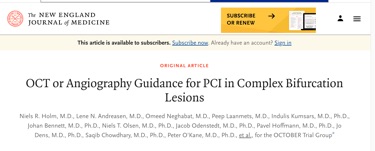IS THERE EVIdence that intracoronary OCT effects morbidity/mortality?

OCT began being used clinically in 2007. But double blind clinical trials confirming its benefit were  lacking SADLY LACKING. So, in spite of developing the technology and owning IP, Dr. Brezinski discouraged its use in reviews and on social media. This changed with the acquisition of LightLab by Abbott in 2017. The more recent trials including ILUMIEN IV and OCTOBER showed both morbidity and mortality benefits with OCT guidance of intracoronary procedures. Fortunately, this establishes lives were being saved back to 2007. A list of the major trials can be found on the Abbott OCT page. First, a study showed OCT changed how interventional cardiologists approached a coronary procedure 70% of the time. How does OCT do it? Trials between 2017 and 2023 have shown OCT guided procedures led to greater stent expansion, which numerous trials show reduces major adverse cardiac events (MACE). For pre-stenting guidance, OCT is used to identify the culprit lesion, assess lesion morphology to select the right lesion preparation strategy, and characterize the stent landing zones to select precise length and diameter of balloons and stents. For post-stenting guidance, OCT offers improved visualization of stent dissection, tissue protrusion, and incomplete vessel wall apposition, thus minimizing stent thrombosis. Using the October trial in the NEJM 2023 as an example, it demonstrated “"Among patients with complex coronary-artery bifurcation lesions, OCT-guided PCI was associated with a lower incidence of MACE at 2 years than angiography-guided PCI." OCT guided procedures also lead to reduced use of nephrotoxic contrast and reduced procedure time (reduced radiation exposure). OCT guidance has also been shown to reduce procedural complications. It is estimated that 200,000 OCT guided coronary interventions were performed in 2023, up from 100,000 in 2016.
lacking SADLY LACKING. So, in spite of developing the technology and owning IP, Dr. Brezinski discouraged its use in reviews and on social media. This changed with the acquisition of LightLab by Abbott in 2017. The more recent trials including ILUMIEN IV and OCTOBER showed both morbidity and mortality benefits with OCT guidance of intracoronary procedures. Fortunately, this establishes lives were being saved back to 2007. A list of the major trials can be found on the Abbott OCT page. First, a study showed OCT changed how interventional cardiologists approached a coronary procedure 70% of the time. How does OCT do it? Trials between 2017 and 2023 have shown OCT guided procedures led to greater stent expansion, which numerous trials show reduces major adverse cardiac events (MACE). For pre-stenting guidance, OCT is used to identify the culprit lesion, assess lesion morphology to select the right lesion preparation strategy, and characterize the stent landing zones to select precise length and diameter of balloons and stents. For post-stenting guidance, OCT offers improved visualization of stent dissection, tissue protrusion, and incomplete vessel wall apposition, thus minimizing stent thrombosis. Using the October trial in the NEJM 2023 as an example, it demonstrated “"Among patients with complex coronary-artery bifurcation lesions, OCT-guided PCI was associated with a lower incidence of MACE at 2 years than angiography-guided PCI." OCT guided procedures also lead to reduced use of nephrotoxic contrast and reduced procedure time (reduced radiation exposure). OCT guidance has also been shown to reduce procedural complications. It is estimated that 200,000 OCT guided coronary interventions were performed in 2023, up from 100,000 in 2016.

